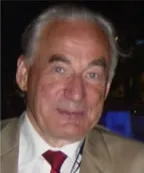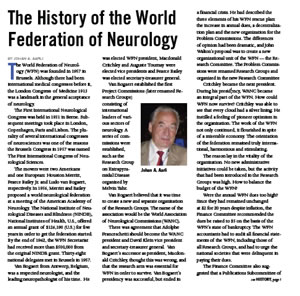Original article by Johan A. Aarli published 24 March 2014 in World Neurology Vol 29 No. 2, History of Neurology
 The World Federation of Neurology (WFN) was founded in 1957 in Brussels. Although there had been international medical congresses before it, the London Congress of Medicine 1913 was a landmark in the general acceptance of neurology.
The World Federation of Neurology (WFN) was founded in 1957 in Brussels. Although there had been international medical congresses before it, the London Congress of Medicine 1913 was a landmark in the general acceptance of neurology.
The First International Neurological Congress was held in 1931 in Berne. Subsequent meetings took place in London, Copenhagen, Paris and Lisbon. The plurality of several international congresses of neurosciences was one of the reasons the Brussels Congress in 1957 was named The First International Congress of Neurological Sciences.
The movers were two Americans and one European: Houston Merritt, Pearce Bailey Jr. and Ludo van Bogaert, respectively. In 1956, Merritt and Bailey proposed a world neurological federation at a meeting of the AmericanAcademy of Neurology. The National Institute of Neurological Diseases and Blindness (NINDB), National Institutes of Health, U.S., offered an annual grant of $126,190 (U.S.) for five years in order to get the federation started. By the end of 1962, the WFN Secretariat had received more than $500,000 from the original NINDB grant. Thirty-eight national delegates met in Brussels in 1957.
Van Bogaert from Antwerp, Belgium, was a respected neurologist, and the leading neuropathologist of his time. He was elected WFN president, Macdonald Critchley and Auguste Tournay were elected vice presidents and Pearce Bailey was elected secretary-treasurer general.
Van Bogaert established the first Project Commissions (later renamed Research Groups) consisting of international leaders of various sectors of neurology. A series of commissions were established, such as the Research Group on Extrapyramidal Disease organized by Melvin Yahr.
Van Bogaert believed that it was time to create a new and separate organization of the Research Groups. The name of the association would be the World Association of Neurological Commissions (WANC).
There was agreement that Adolphe Franceschetti should become the WANC president and David Klein vice president and secretary-treasurer general. Van Bogaert's successor as president, Macdonald Critchley, thought this was wrong, and that the research arm was essential for WFN in order to survive. Van Bogaert's presidency was successful, but ended in a financial crisis. He had described the three elements of his WFN rescue plan: the increase in annual dues, a decentralization plan and the new organization for the Problem Commissions. The differences of opinion had been dramatic, and John Walton's proposal was to create a new organizational unit of the WFN — the Research Committee. The Problem Commissions were renamed Research Groups and organized in the new Research Committee.
Critchley became the next president. During his presidency, WANC became an integral part of the WFN. How could WFN now survive? Critchley was able to see that every cloud had a silver lining. He instilled a feeling of pioneer optimism in the organization. The work of the WFN not only continued, it flourished in spite of a miserable economy. The orientation of the federation remained truly international, harmonious and stimulating.
The reason lay in the vitality of the organization. No new administrative initiatives could be taken, but the activity that had been introduced in the Research Groups was high. How to balance the budget of the WFN?
Were the annual WFN dues too high? Since they had remained unchanged at $2 for 20 years despite inflation, the Finance Committee recommended the dues be raised to $5 on the basis of the WFN's state of bankruptcy. The WFN accountants had to audit all financial statements of the WFN, including those of all Research Groups, and had to urge the national societies that were delinquent in paying their dues.
The Finance Committee also suggested that a Publications Subcommittee of WFN be formed and chaired by Professor Robert Daroff. The subcommittee was charged with development of resources from WFN-sponsored journals, starting with the contracts of the Journal of the Neurological Sciences, Journal of Neuroimmunology, Acta Neuropathologica and the WFN's World Neurology newsletter. It also was decided to have the WFN accountants shift from a cash to an accrual method of accounting commencing Jan. 1, 1987. Any further increase in the number of WFN officers, which would progressively jeopardize WFN's finances, was strongly discouraged.
The WFN Finance Committee recommended that a Fundraising Subcommittee be formed, chaired by Professor Helmut Lechner to investigate. Registration fees, advertisements, exhibit hall rentals and sponsorships were new sources of income.
John Walton took over as the new WFN president in 1998. One of the most central steps of the subsequent WFN re-organization was to establish a corporate status for the association. The impending appointment of officers based in different countries and continents made the creation of a new secretariat pressing. The committee structure had to be reviewed. Financial planning systems, including itemized annual budgets, were introduced and expenditure monitored by the treasurer and reported to the Finance Committee.
It was recommended to separate the offices of secretary-general and treasurer. Following the World Congress in Vancouver, Canada, in 1993, 50 percent of the profits were retained by the host society and 50 percent were transferred to the funds of the WFN, in return for the WFN administrative costs involved in planning the congress and program.
The WFN income increased because of the increase in annual dues and the royalties from its scientific journals. Developments in neurosciences had increased, and effective new drugs were available.
James Toole was the WFN secretary-treasurer general in Richard Masland's administration. They managed to have the new WFN newsletter, World Neurology, survive, and it became an important communication medium for the federation. In 1989, Toole became the editor-in-chief of the Journal of Neurological Sciences.
The U.S. Congress in concert with President George H.W. Bush, declared the 1990s the "Decade of the Brain." In response to a request by the Congress, the Advisory Council of the National Institute of Neurological Disorders and Stroke produced an implementation plan, focusing on 14 major disease categories in which neurological research gives promise of rapid progress for the coming decade. The plan called for increased allocations for basic and clinical neurosciences of $190 million in the first year, rising to $385 million per year in the latter part of the decade.
Jun Kimura was the first vice president in James Toole's administration. He also chaired the Constitution and Bylaws Committee during the critical transition period from the "old" organization to the incorporated WFN. Many of these important projects stemmed from the Strategic Planning Meeting held in St. Albans in 2000, making steady progress in achieving some of the missions agreed upon during those intense discussions.
Johan Aarli had two main initiatives as president of the WFN. He articulated the need to study and develop creative methods to implement improved delivery and increased rural distribution of neurological health, "The Africa Initiative." Second, he was determined to bring into the WFN the 1.2 billion people within The People's Republic of China. This took place at the WFN's Silver Jubilee in 2007.
The Council of Delegates remains the ruling body of the federation. WFN must hold an annual general meeting which all member societies are entitled to attend. It consists of the national delegates of the national neurologic associations. There is a quorum of a meeting of the Council of Delegates if the number of authorized delegates personally present is at least 15.
What's in a Name?
From 1993, the president, the secretary treasurer general, the first vice president and the chairman of the research committee constituted the WFN Management Committee. Their function was to advise the Council of Delegates and the various committees of the issues of policy and day-to-day management. The WFN Steering Committee was disbanded when the new WFN was organized in 2001.
The WFN Trustees
One major element of the new WFN is the appointment of trustees: the president, the first vice president, the secretary-treasurer general, and three who are elected in accordance with the articles of association, and up to two co-opted individuals. The trustees are charity trustees who have control of the federation and its property and funds.
Two WFN members have contributed to this account of WFN's history: Noshir Wadia: In Service of the WFN, and Jun Kimura: Internal Struggle in Kyoto.








